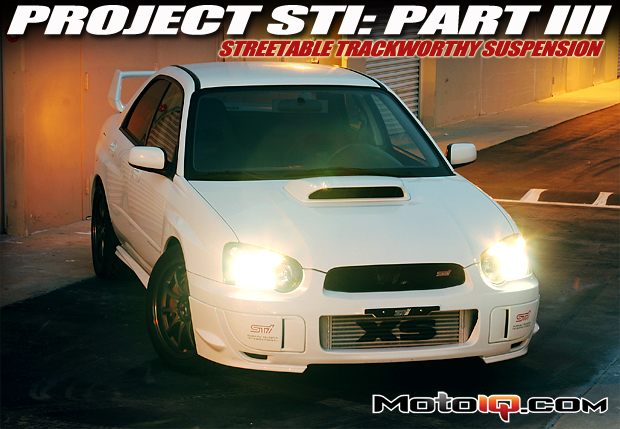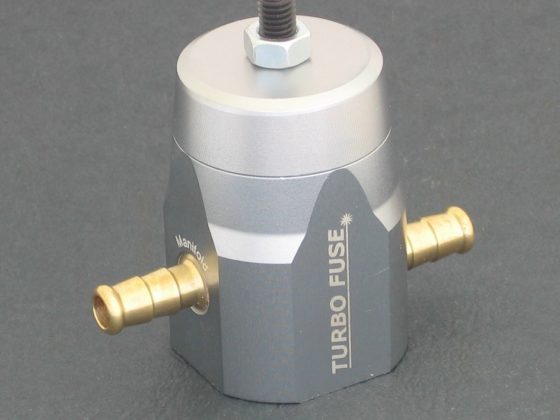
Project Subaru WRX STi Part 3: Streetable Track Worthy Suspension
By Mike Kojima
In our last segment of Project Subaru WRX STi we tackled the car’s weakest area, its handling, and made significant improvements by installing Whiteline’s basic handling pack suspension kit. Although we were very favorably impressed with the kit’s enhancement of Project STi, we needed more. We wanted more than just a better handling car; we wanted one that had the potential to put the hurt on the competition in time attack events as well as a decent street ride because this car also serves as a daily driver.
To see the other articles in this series, click here!
Although the stock STi dampers are valved more stiffly than the base model WRX, we wanted something with higher spring rates and more damping, especially with our sticky tires. When pushed hard our car would exhibit float, body roll and poor transient response. The STi had an edgy feel to it where it would break loose when turning in without giving much warning to the driver.
 |
| The KW Variant III suspension is one of the most advanced street suspension packages on the market featuring independently adjustable compression and rebound damping, remote accumulators and sophisticated multistage frequency sensitive valving. |
We also wanted to lower our ride height to lower our center of gravity and to reduce weight transfer under cornering to the outside tires without reducing bump travel. What most people don’t realize is that simply lowering many cars reduces bump travel to the point where the car rolls onto the bump stops as soon as hard cornering is established. This causes severe over or understeer depending on which end of the car runs out of travel first. In order to handle well the car must be kept off the bump stops. This is the first golden rule of good handling that most people ignore.
The first and most critical parts of any suspension build are the dampers and springs. We chose KW Suspensions Variant III coilovers because we feel that they are one of the best street suspensions out there for the serious driver. Variant III’s are a unique advanced gas charged double damping adjustable twin tube damper. Although some people may dismiss twin tubes as low end dampers compared to monotubes, the KW’s are a high precision twin tube with the characteristics of a monotube. The KW Variant III’s independent adjustability of compression and rebound damping is also a huge advantage over other streetable suspensions. Independent adjustability of compression and rebound damping is important for any car that is going to be tuned for optimal handling under a wide range of set ups and conditions like a dual purpose street/track car.
 |
| The low speed rebound damping is controlled mostly by the piston on the end of the shock rod. Turning the rebound adjusting knob located on the top of the shaft screws the tapered metering rod “V” up and down varying the size of the orifice. The low speed fluid flow is represented by the green arrows. At higher shaft speeds the mid and high speed circuit kicks in, the high speed fluid flow is shown by the blue arrows. The hydraulic pressure deflects the metering disc shown in yellow for mid speed damping and higher velocities allow the spring loaded blow off of the disc to open. |
The rebound adjustment primarily affects the low speed damping–shock piston velocities in the 0-2″ per second range. Low speed damping adjustment affects body motions such as roll and pitch. This is in the area which the driver feels the most when driving fast. The V3 has the main shaft and piston riding in the inner tube of the shock body with the rebound damping adjuster built into the low speed circuit. A threaded tapered rod that goes to a knob at the top of the shaft controls the size of the low speed damping orifice. The knob is adjusted with an allen wrench. Screwing it in and out raises and lowers the tapered end of the rod into the orifice which changes the amount of fluid that can flow through it. When the orifice is mostly blocked by the taper, little oil can flow and there is a lot of low speed damping. When the orifice is open, the fluid can flow freely and the damping is decreased.
The piston also has a unique two stage system combining a deflected disc valve system and a spring loaded blow off valve for controlling the rest of the velocity range.
The foot valve lives on the bottom of the inner tube and regulates the flow of fluid between the inner and outer tubes. A spring loaded needle valve controls the size of the low speed compression damping orifice located in the foot valve as well as the valve spring preload. The needle valve is adjusted via an allen screw on the bottom of the shock body. Like the rebound, the compression adjuster also mostly influences low speed compression damping, which like rebound is the part of the damping curve that influences body motion. On rebound the fluid flows through orifices and the damping force is controlled by the unique combination of deflected dics valves with a spring loaded blowoff function. The combination of deflected disc valving and spring loaded blow off give KW’s their unique range of control with frequency sensitivity. This helps the shocks produce both firm control and a smooth non tire shocking ride.
 |
| In rebound, the shocks foot valve located on the bottom of the shock, simply acts like a one way check valve allowing fluid displaced by the shock shaft to flow into the outer tube and the hydraulic accumulator. |
In grassroots motorsports where you don’t have a large pit crew and in dual purpose track street cars, being able to quickly and easily adjust the damping is important. Some double adjustable shocks require disassembly of the shock assembly so a button can be pushed while the shaft is rotated and other time consuming methods. The KW’s easy to reach external adjustments make dialing in the chassis a lot easier.



